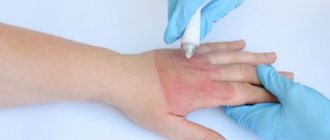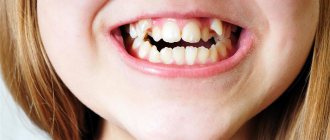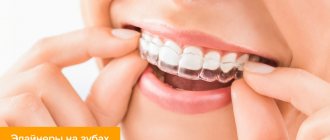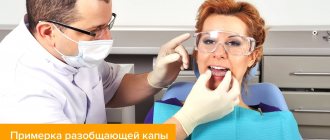A good replacement for braces are teeth straightening aligners made of elastic material. From this article you will learn about the differences between the design and braces and its effectiveness.
Aligners are removable orthopedic structures used in dentistry to correct minor defects in the dentition and bite. Outwardly, they are similar to the mouthguards that boxers use to protect their teeth.
For production, elastic materials are used, which form a transparent overlay after melting.
The principle of operation is based on slight pressure from the aligner, as a result of which the alveolar tissue is slightly resorbed.
This allows the tooth to move in the right direction. The pressure force is moderate, so it will not be possible to correct complex malocclusions and uneven teeth using a silicone mouth guard.
Stages of treatment
Treatment of minor malocclusions and crooked teeth with aligners is performed in stages.
- At the first consultation with a doctor, an examination of the oral cavity is performed. Diseases of the teeth and oral mucosa are identified, and various methods are used to eliminate the inflammatory process and caries.
- Next, together with the orthodontist, the type of aligners is selected , after which a treatment plan is developed.
- Impressions are taken from both jaws. The working material is a special mass with a pleasant mint taste. The cast hardens in just a couple of minutes.
- The silicone impression is sent to the dental technician's laboratory , where he makes a plaster model of the aligner. After this, the specialist manually adjusts each tooth.
- The treatment process is divided into stages, for each of them a different aligner model is developed. The number of trays in the set is determined by the complexity of the defect and the anatomical features of the patient’s jaw.
- At a doctor’s appointment, the patient tries on the first aligner and receives recommendations for further use of the aligners, as well as for caring for the structure.
What result can you expect
Today, only some, the most severe, malocclusions cannot be corrected with aligners. Typically, these are situations where jaw surgery is required. In this case, the doctor may recommend permanent braces (before or after surgery), and sometimes an orthodontic facial mask is required.
But most disorders are classified as mild or moderate, and all of them are corrected with the help of removable mouthguards.
The doctor always develops a treatment plan so that the result is ideal: straight teeth and their correct closure. Moreover, if there are impacted teeth, they try to preserve them, that is, bring them to the correct position, and not remove them.
With aligners, you can count on the fact that your bite will be perfect: both the position of the teeth and the closure of their rows will be absolutely correct. Typically, the orthodontist does not stop treatment until this result is achieved.
Contraindications to treatment with aligners
Experts identify a number of restrictions on the use of aligners to correct dental defects. These include:
- destruction of alveolar bone tissue;
- acute periodontal diseases;
- tartar;
- skeletal abnormalities of the jaw;
- TMJ diseases;
- somatic disorders;
- impacted teeth.
The decision to correct a bite with braces is difficult for patients. The main reason is the duration of such treatment and the lack of attractiveness of braces. Using clear aligners to straighten teeth has become the most acceptable option to correct the situation.
At the moment, there are various ways to correct a bite. One of the most modern and effective are aligners for teeth straightening. They are manufactured and selected taking into account the characteristics and wishes of the client.
How long should you wear aligners?
18 hours a day is the optimal minimum wearing time. The total duration of treatment depends on the complexity of the case and in each situation this issue is resolved individually. A good dentist in Moscow familiarizes the patient with all the stages and nuances before installing aligners.
Are there any restrictions when wearing aligners?
With aligners on your teeth, you cannot eat, drink any drinks other than water, or chew gum or candy. It is recommended to avoid contact sports such as boxing or others where there is a risk of injury.
But when the aligners are removed, there are no restrictions: everything depends on the patient’s comfort. You can eat any food, including solid foods, undergo almost all medical and cosmetic procedures (we wrote about this in more detail), and brush your teeth with any brush.
Aligners should be stored in a container, and cleaned with care - there is a risk of breaking them.
An orthodontist can tell you more about all stages of treatment during a consultation. In terms of orthodontic bite correction, each patient has individual characteristics that are identified at the preparation stage. In any case, the entire process of correcting the bite can be seen in advance in the format of a computer model. When choosing aligners, patients know in advance the duration of their treatment and can assess the future result.
Aligners for bite alignment
Aligners are elastic transparent trays that are applied to the entire dentition. They resemble trays used to lighten enamel. The patient can put on and take off the aligners on their own; it doesn’t hurt at all. Unlike braces, they do not need to be worn constantly. The aligners can be removed before eating or brushing your teeth.
You can learn all about them from your orthodontist. The main purpose of aligners is to correct the bite. They apply imperceptible and painless pressure on the teeth, directing them in the desired direction. The main requirement is to wear them at least 18 hours a day. The wearing time may vary if the bite defect is too noticeable and severe. In case of serious disorders, mouth guards must be worn constantly.
Aligners are made from a synthetic transparent material. This makes them almost invisible, which is very important for those who are worried about their smile after installing braces. Also, mouth guards do not require wearing for years.
Typically, aligners are made as a set and given to the patient in several pieces. The doctor will schedule. After some time, one mouth guard is replaced by another.
The material is selected in such a way as not to injure teeth and gums, provoke an allergic reaction or cause discomfort. This is not a scam, this is the optimal solution!
Pros and cons of braces and aligners
Both systems have their advantages and disadvantages. When choosing, you need to listen to the opinion of the orthodontist and be guided by financial capabilities. Braces are a complex structure of locks that are attached to the teeth. Accordingly, the special bracket with which they are connected has a fairly strong effect that changes the configuration of the dentition.
Due to this design, braces often create discomfort for the patient. The point is not only about constant pressure on the teeth, but also about damage to the mucous membranes, especially in the case of the lingual model (placed from the inside).
Aligners are plastic aligners that are much more comfortable to use. They do not have sharp edges, and if necessary, they can be removed at any time for brushing teeth, eating or attending a public event. In general, aligners do not disrupt a person’s usual rhythm of life. Just don’t take long breaks from wearing them, but the orthodontist will definitely warn you about this.
Aesthetics
This is an important aspect in dentistry. This applies not only to crowns or fillings, but also to orthodontic treatment. The aligners are made of transparent elastic material, so they are almost invisible on the teeth. Even during close contact or conversation, interlocutors do not always notice the presence of corrective structures in the mouth. Braces are much more noticeable, although there are exceptions. There are ceramic and sapphire products. In this case, the locks are selected to match the enamel, and the orthodontic wire can be transparent or also blend in with the color of the teeth. Among braces, there are also lingual models that are attached to the teeth from the inside. They are just inconvenient and very expensive.
Correction efficiency
It is difficult to say for sure which system is more effective, but in some cases it is not advisable to install braces. It used to be that they worked better, but this is not always the case. For example, in difficult situations that require body movement of teeth, braces make it easier and faster to correct the dentition. Aligners also do an excellent job, although in advanced cases they take a little longer. Despite this, they are better suited for correcting crossbites or straightening individual teeth. As for classic braces, they are considered the heavy artillery. These designs cope well with the task, even if it is a complex clinical case.
There are also nuances. For example, if you need to correct a deep bite, it is better to choose lingual braces. Ceramic or sapphire are more fragile, and any breakage can have a negative impact on the duration of the course. Although in this case you need to be prepared for constant discomfort. Aligners can correct this situation with much less inconvenience, even if it takes a little more time.
addictive
Regarding adaptation to the bite correction system, aligners are more preferable. They are more convenient and rarely lead to complications. Rarely, gum irritation or bleeding may occur. Typically, a small adjustment will correct these problems. Wearing braces comes with a number of inconveniences. For example, before attaching lingual models, dentists note that the tongue can be injured. Speech disturbances and simply discomfort are also possible.
Eating habits
Braces cannot be removed before eating, so patients are advised to follow a diet. It is advisable to cut hard foods into pieces, and it is better to avoid seeds and nuts altogether. When using aesthetic braces, the diet becomes even smaller - you need to remove all foods and drinks with coloring properties from it. In the case of aligners, everything is simpler, since you can remove them at any time and eat whatever you want. There are no restrictions. The main thing is to thoroughly brush your teeth after eating, and only then put them on.
Hygiene
When using aligners, oral hygiene is standard, since they can be removed at any time. With braces everything is more complicated. The design makes it difficult to brush your teeth, as plaque accumulates under the orthodontic wire, around the locks and in other corners. Before installing braces, the patient is taught hygiene rules. The orthodontist teaches you how to brush your teeth and use additional products such as rinses and brushes. This is the only way to prevent caries and other complications.
Price
This is the question patients most often ask orthodontists when starting to compare braces with aligners. Their cost is similar if you order an aesthetic design. As for metal braces, they are cheaper and even very effective, but they look extremely unaesthetic and create discomfort.
Design differences
Structurally, they differ very significantly. Braces are metal or ceramic elements for teeth, connected by a metal arch. Under the influence of metal, the teeth return to their original position, causing the teeth to move in the desired direction. The clasps are permanently held on the teeth. Aligners are mouthguards, or rather removable covers for teeth made of transparent plastic. Each cover is put on a tooth. Patients receive them in a case. Each set, depending on the curvature of the teeth, can consist of 20-40 pairs, which need to be gradually changed every two weeks. Each mouthguard has a specific effect, returning teeth to the desired positions.
The main design differences between bracket systems and aligners are:
- Invisibility of clear aligners. Even aesthetic braces do not have such properties. As for hidden lingual systems, they have a lot of disadvantages - from inconvenience to problems with pronunciation.
- The aligners can be removed when needed. Braces, due to their design, do not allow this.
- The aligners are smaller , so the cheeks and lips move less than a millimeter away from the teeth. In the case of braces, they move by at least 2 mm.
Popular aligner manufacturers
Aligners are a relatively new invention in dentistry. They began to be actively used in the early 2000s. Initially, they were produced only by an American company, but then other countries began to produce high-quality aligners.
At the moment, the most popular manufacturers of aligners are:
- Star Smile. The price of these mouthguards is not that high since they do not have to be shipped from the USA. The aligners are manufactured in Moscow, but using American technology. The mouthguards are also changed every 2 weeks, the course of treatment is up to 15 months.
- Orthosnap. One of the cheapest aligners. Computer modeling is not used in their manufacture, so it is difficult to judge their effectiveness.
- Clear Correct. These mouth guards are suitable even for those who have very sensitive gums and have a reaction to synthetic materials. They are made in the USA.
- Invisalign. Invisalign appeared on the Russian market earlier than other aligners. Therefore, many dentists prefer to trust this brand. These aligners are usually changed every 2 weeks. They are highly effective, but the price is also quite high.
It is worth clarifying that in the clinic the doctor only takes pictures and modeling. The aligners themselves are manufactured in the country where the manufacturer is located.
Kinds
In dentistry, aligners are used that are practically invisible. They can be made of plastic and silicone. There are children's and adult mouthguards. In addition, mouth guards can be selected from different manufacturers that offer aligners in different price segments:
- Invisalign. They have a special unique fastening system, which makes wearing the structure quite comfortable for the patient.
- 3D-smile. Transparent designs that allow you to cope even with significant malocclusions.
- Ortosnap. The most affordable option for many due to the fact that the structure is made of plastic.
Rules for wearing and care
Successful correction of occlusion is impossible without careful adherence to the orthodontist’s recommendations. Our dental center specialists advise:
- wear mouth guards daily for 22 hours;
- remove orthodontic products before eating or drinking hot drinks;
- brush or rinse the aligners with running water before each use;
- To clean the trays, use special pharmaceutical disinfectants or (if slightly dirty) a soft brush and paste. Note: Products cannot be boiled or washed with hot water;
- Use special containers for storage.
As you can see, the rules are simple and easy to follow.
Our clinic
Dentistry "Implantmaster"
5.0 – 79 reviews
- Maly Sukharevsky Lane, 9, building 1, Moscow 115280
- Tsvetnoy Boulevard
- Pipe
- Sukharevskaya
- Mon-Sat: from 09:00 to 21:00; Sun: Closed
More details
Sign up for a consultation
Correcting the bite surgically
The absolute indications for the intervention of maxillofacial surgeons are the consequences of a pathological bite that affects the health of the body.
- Difficulty chewing food, swallowing and breathing.
- Pathological conditions of the TMJ.
- Chlo injuries.
Also, such types of pathological occlusion as mesial and distal, in some cases in adult patients, will not be completely corrected with braces. Surgery will be required to improve facial signs.
To correct the bite in adults, plastic surgery of the jaw bones is performed using surgery: tissue expansion or elimination of excess. This technique is always accompanied by additional treatment using devices (plates, braces) after surgery.
Pros. Corrects bite pathologies of any complexity.
The disadvantages are:
- traumatic;
- long rehabilitation time;
- a large number of restrictions.
But such serious disadvantages are compensated by achieving high-quality and stable results.
Using veneers
Veneers and lumineers are orthopedic onlays made of porcelain, ceramic or composite material. Correction of the bite in adults without braces will not happen with the help of veneers, but a certain masking of defects is possible.
Veneers and lumineers differ in the thickness of the plate walls. Veneers are up to 0.6 mm thick and the tooth enamel underneath must be ground off before being fixed. Lumineers are no larger than 0.3 mm and are fixed directly to the tooth without grinding, but are ineffective on large units.
Patients often wonder about correcting their bite with such overlays. Yes, they look aesthetically pleasing and have the same hygiene as your own teeth. However, it is impossible to correct the bite with veneers or lumineers, only to disguise it.
The main task of the overlays:
- align the shape and height of units in the smile area;
- hide, if any, discrepancy between the shades of fillings and enamel;
- mask interdental spaces and defects in enamel.
With the help of such orthodontic structures, you can give your smile a certain aesthetics and make it even. They last a long time, and with careful oral care they can last up to 20 years.
Correction (masking) of a bite in adults at a price will depend on the number of overlays. One such design will cost around 30 thousand rubles.
Operating principle of the devices
For one course of corrective therapy, several copies of trays are made, each of which differs in minor changes in the positioning of dental units. The number of sets (from 10 to 40) and the step of geometric parameters are calculated on a computer using special software, which calculates distances and angles of movement with perfect accuracy.
The essence of corrective therapy with aligners is to create constant soft physical pressure, which forces the dental elements to move in a given direction. The bone tissue dissolves in the direction of the impact, the teeth move a little, and where they were before, new bone tissue is formed.
As intermediate stages are completed, the patient himself changes the aligners in strict accordance with the numbering of the copies.
Get a consultation
We will answer all your questions before visiting the clinic!
+7
Online registration
Content
1 Consequences of malocclusion
2 Correction of bite after 30 years
3 Modern methods of correcting bites in adults 3.1 Correcting bites with braces
3.2 Orthodontic plates for teeth
3.3 Trainers for teeth straightening
3.4 Aligners – transparent aligners
3.5 Correction of the bite surgically
3.6 Use of veneers
4 The price of bite correction at the Implantmaster clinic
Orthodontic treatment and basic devices
As you know, orthodontists are involved in identifying, eliminating and preventing dental anomalies. In their opinion, regardless of the patient’s age, there is always the opportunity to move the tooth to the right place, as well as to stimulate or inhibit the development of the bone structures on which the teeth are attached. This is due to the compliance of the supporting-retaining apparatus.
There are several ways to perform orthodontic treatment, namely:
- Conservative therapy. It consists of using special devices: braces, transparent aligners, thin overlays on teeth, etc.;
- Surgical intervention. This method is used in difficult situations when it is not possible to eliminate the defect using orthodontic appliances. However, a prerequisite after surgery is the use of braces or transparent aligners.
To understand what is better to choose after surgery - aligners or braces - you should pay attention to the following criteria.
Advantages and disadvantages
Aligners, in comparison with other orthodontic devices, have a whole list of significant advantages:
- excellent aesthetics - the products are transparent and therefore do not spoil the aesthetics of the face;
- easy to take off and put on;
- fast adaptation;
- Easy to care for – the mouth guards are easy to clean. Oral hygiene is carried out as usual;
- no need to change your diet - the aligners are removed when eating;
- safe operation - there are no parts that could injure the mucous membrane of the lips and cheeks;
- reliable fixation - the configuration of the products, identical to the contours of the dentition, ensures a tight fit to the enamel surface, preventing possible loss.
Among the disadvantages, it should be noted the limited effectiveness of use in correcting complex dentofacial anomalies. Not all defects can be corrected using this method.
Important: only an orthodontist, after a thorough examination, can determine which type of orthodontic corrective equipment will be effective in a particular clinical case.
Correction of bite after 30 years
In most cases, the main bite correction is performed in childhood using removable and non-removable appliances. Caring parents who have noticed abnormal growth of milk or permanent units in their children often ask orthodontists about the appropriate age range for treatment (when to start and how many years to reach it).
Not all anomalies can be corrected in the primary or mixed dentition. Sometimes you should wait until 12–14 years of age, when the bone structures are formed but still plastic. Then it is possible to carry out quick and effective treatment. However, while waiting for therapy, the child already accepts his appearance as is, not paying attention to crooked units. Problems make themselves known much later (after 40 years), when pain occurs in the TMJ, thinned enamel becomes sensitive, multiple caries occurs, difficulty breathing, and migraines appear.
Therefore, if bite correction was not carried out as a teenager, then it is not too late to correct a malocclusion in an adult at 30 years old. And the most important thing that a patient of any age should hear from an orthodontist is that it is never too late to start correcting the bite.
Of course, the older you get, the harder it is mentally and physically. However, by taking care of your smile, the patient will immediately solve many health problems that bother him, and will also look younger. It is not easy to get ready to wear braces for a long time, usually used on teenagers. However, in the orthodontic field, a lot of different equipment has appeared that will not be visible when worn and is an alternative to braces. Highly qualified orthodontists at Implantmaster will select the appropriate design and treatment plan specifically for your case.
Indications and prohibitions for occlusion correction using aligners
What defects are treated with mouth guards:
- tilting or turning of teeth;
- non-critical pathologies of occlusion;
- crowded arrangement of dental elements or, on the contrary, large gaps between them.
Contraindications for installation:
- periodontal disease in the acute phase;
- mental illness;
- the presence of impacted (formed, but not erupted) dental units;
- jaw anomalies.
Indications and contraindications are identified by the dentist at a consultation after visual and hardware diagnostics. Our dental centers are equipped with all the necessary equipment to perform diagnostic and therapeutic procedures.









